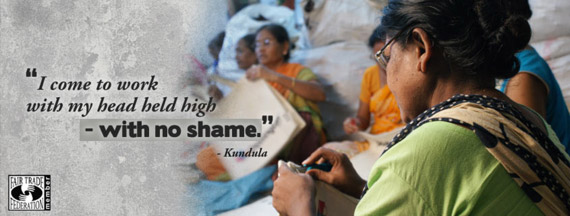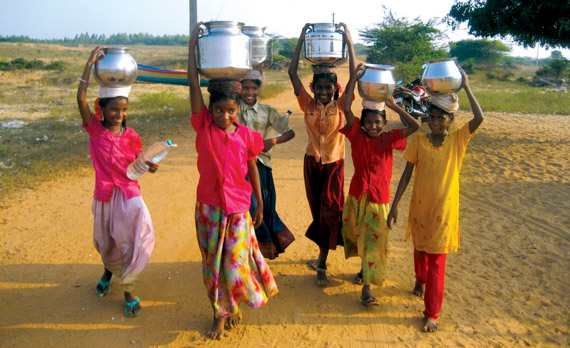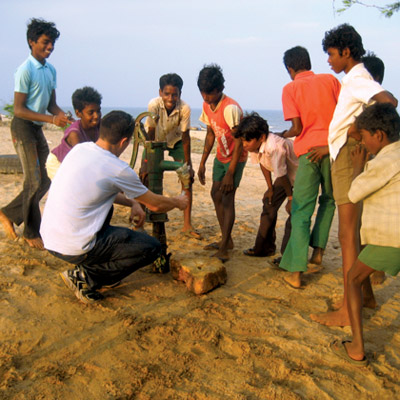A Passion for Change Humanitarian Engineering
Be the change you wish to see in the world,” said Mahatma Ghandi. Both the ethics of justice and the ethics of care compel engineers and architects to take these words to heart as they work to make the world a better place through humanitarian engineering. Humanitarian engineering, according to the University of Washington’s Ryan C. Campbell and Denise Wilson, “can be defined as the application of engineering skills or services for humanitarian aid purposes, such as natural disaster recovery or improving the prospects of people in impoverished areas. The field . . . has great potential for many of the world’s problems, and if the success of such organizations as ‘Engineers Without Borders’ is an indication, it is sure to continue its rapid course of growth.
Uniquely qualified because of the type work they do, engineers and architects not only understand the problems associated with community development, disaster relief and underdeveloped areas, they have the know-how and motivation to provide solutions in an environmentally, socially responsible and sustainable way. This holds true whether the task is a water sanitation project in Bolivia or a 70-foot-long walking footbridge at a Girl Scout camp in Omaha, Neb. These professionals give selflessly of their time, talent and skills through their volunteer work, which supports both community service organizations and professional organizations unique to their field.
For example, Engineers Without Borders (www.ewb-usa.org and www.ewb-international.org) is dedicated to developing communities’ quality of life worldwide by implementing sustainable engineering projects. Water For People (www.waterforpeople.org) supports safe drinking water and sanitation projects in developing countries. Design 4 Others™ (design4others.org) plans and designs critical-need facilities for communities with limited resources. And, Architecture for Humanity (www.architectureforhumanity.org) promotes architectural and design solutions to global, social and humanitarian crises. In addition, humanitarian engineering and social entrepreneurship courses and programs are now widely available throughout many U.S. post-secondary institutions.
Below are just a few of the people and projects facilitating positive change in the world.
Replacing Hand Pumps in India with a Reverse Osmosis Facility
In 2008 Eric Scherch gave a presentation at the United Nations Educational, Scientific and Cultural Organization’s (UNESCO) International Conference on Water Scarcity, Global Changes and Groundwater Management Responses as a direct result of his Engineers Without Borders (EWB) – USA experiences in India. His presentation, “An Aid Worker’s Perspective on the Social, Environmental and Economic Challenges to Achieving a Sustainable Solution,” marked a continuing commitment to providing India with clean water.
In January 2010, he and fellow HDR staff engineer Joel Engleson used their vacation time and time off without pay to support the village of Chakicherla Pedda Patapu Palem (CPPP) in the Indian state of Andhra Pradesh. Villagers had been using two public hand pumps to get potable water from a small aquifer, although one pump would frequently run dry during the dry season. In addition, the walk to the hand pumps took approximately 25 minutes and was typically made by women and girls twice per day. The new EWB project will change their lives by providing potable water to approximately 4,000 people.
The 2010 trip, built on previous San Diego EWB Chapter efforts, focused on determining the feasibility of water treatment alternatives in addition to gathering field data to support the chosen treatment solution design. After assessing site conditions, performing a sustainability analysis, and meeting with village leaders to gain an understanding of villagers’ support for different treatment alternatives, a reverse osmosis system was determined most feasible.
The project design has since been completed and construction begun on the facility. The project team is currently managing construction from the United States with support from their partner organization ASSIST in India. Scherch and other project volunteers will be travelling to CPPP in October 2011 to inspect construction and oversee training of the village staff that will operate and manage the reverse osmosis facility.
Engleson described their days in the field as long and varied, but rewarding and fun, with the work being some of the most challenging he had ever done. The local San Diego EWB chapter is currently fundraising to support this project. Donations can be made at www.ewb-sandiego.org.
Providing Community Education & Sanitation in Bolivia
Ilke McAliley. P.E., left Istanbul, Turkey in 2000 for a one-year student exchange program in environmental engineering graduate study at Clemson University. Ten years later that exchange program had turned into a family, U.S. citizenship and an ongoing relationship with Water For People (WFP).
McAliley, an HDR environmental engineer in Charlotte, N.C., is currently involved in a study in Bolivia on advocacy, outreach and development of communication tools in communities WFP had previously worked with on water and sanitation improvements. The North Carolina WFP committee was invited to participate in the study because of its earlier engagements, particularly in Cochabama, beginning in the 1990s. McAliley, a team member on 2008 and 2009 trips, helped conduct workshops with municipality decision makers, community leaders and sanitary officers focused on ways to accomplish behavior change using social, news and print media to increase improved systems awareness.
“Providing a pump, clean water or sanitation facilities is just a small part of the equation,” McAliley said. “What is more important and what keeps it sustainable and long-term is the buy-in from the communities, their willingness to maintain their system and to establish a way to pay for it. They also have to understand why – why do they have to use the facilities or clean water; what happens if they don’t; and how does it affect their quality of life? Changing a habit is the most difficult thing for anyone,” she added.
McAliley is passionate about WFP because she says it believes in people, helps communities help themselves, keeps it local and does not leave until the work is completed. This project will be completed by year-end 2011 or early 2012.
Freeing Women & Children from Asia’s Brothels

© Fair Trade Federation and Freeset
Sonali was 13 when she was sold. She was brought from a quiet village into the back streets of Kolkata, India, a massive city of more than 14 million, to work in the red light district. With no education and no other choices, she has continued to work there for 30 years. Sonali was the one sacrificed so her family could eat.
Ten years ago, another family moved to the red light district. They left their lives in New Zealand and started the business Freeset (www.freesetglobal.com), which produces bags and T-shirts to employ women from the sex trade. Currently their factory employs more than 160 women in the heart of one of the Asia’s largest red light districts.
In addition to providing a means for social justice, their business lauds itself as being environmentally friendly with biodegradable jute bags and organic cotton T-shirts. To produce these items, Freeset uses screen printing for graphics, which generates wastewater from equipment cleaning. The company wanted to develop a process to remove paint from the water before it goes down the drain in order to maintain good sustainable practices.
Eric Habermeyer, an HDR water/wastewater engineer and Engineers Without Borders volunteer, provided the solution. He spent one month of his vacation last summer working with the manufacturer to develop a viable treatment process, which uses locally available chemicals and equipment to remove paint from the wash water.
Freeset’s founder, Kerry Hilton, says that you can take a woman out of a brothel, but if you don’t provide a job, how can she be independent? A sustainable wage and place of work, like Freeset, are large steps toward empowerment and independence.
Changing Lives in Uganda with Water Systems
A continent away in Uganda, another EWB project has special meaning to Sujatha Nagulapally. As a student at Kansas State University, Nagulapally was involved in the university’s EWB student chapter. When she joined HDR in 2007 she wanted to continue her organizational involvement, but there was no professional chapter in Nebraska. So, she helped form the new chapter, which began in 2008-2009 with Nagulapally as its vice president.
One of the new chapter’s first projects, at the request of a Colorado church, was to assist in building a water system in several Ugandan communities. After an initial Fall 2010 assessment trip to Gayaza, Myanzi, Wambale and St. Kizito, the EWB engineers identified water supply/water quality as the best project. Because the area receives substantial annual rainfall, a rainwater harvesting component was earmarked for the project. Rainwater will be collected from the medical clinic building roof through gutters into water tanks with a small chlorination system installed on top of the tank. The water sanitation work will make clean chlorinated water more accessible for residents who would otherwise walk long distances for clean water – a task that typically falls to women and children. In fact, the latter sometimes have to miss school to perform the task.
Rather than working on-site with the project, Nagulapally works behind the scenes on design, fundraising and administrative functions to help make the work possible. This particular project has special significance for the water/wastewater engineer because water wasn’t immediately available to her or her family while growing up in her native India. As a result, she and her brother frequently made daily trips for fresh water by bicycle after school and on the weekends.
Nagulapally would like to travel with the team to Uganda, but seeing the videos, photos and children’s smiles, and knowing the chlorination system will help make water more assessable, more than make up for her hard work. “Water will be more available and will enable the children to attend school, so it will be satisfying to know this project made a difference in somebody’s life,” she commented.

Photo Credit: Eric Scherch
Making an Impact on Resource-Poor Communities
Design 4 Others™ (D4O) is a volunteer group of professionals who plan and design critical-need facilities for communities with limited resources. The organization was started by CUH2A and continued when HDR acquired the firm. Now, more than 100 volunteers from multiple offices are involved in the organization, and the Ontario office has created Design 4 Others-Canada.
The group originated after a successful collaboration on the Infectious Diseases Institute (IDI) with Makerere University, Pangaea Global AIDS Foundation, Academic Alliance Foundation for AIDS Care and Prevention in Africa, Pfizer Foundation and Pfizer Inc. IDI is a state-of-the-art clinical care facility at the Makerere Campus’ School of Medicine in Kampala, Uganda. The facility opened in 2004 and serves as an HIV/AIDS clinic, providing treatment to thousands of patients every month. It also serves as a regional training center for physicians and nurses, and a research facility to strengthen care protocols and to support prevention programs.
“This project really affected us in a positive way,” said Lynn Mignola, principal strategic planner and IDI strategic facility planner. “Suddenly our work had a place in a larger world. As individuals we could impact a nation with critical needs; we could see our work directly helping people in dire situations,” explained Mignola.
After IDI’s success, a grassroots effort emerged to form D4O. According to Scott Butler, program director for the science and technology business group, “It began as a way to focus the energy and expertise of volunteers into a powerful team, which might not otherwise be as effective as individuals.”
The main goal of D4O is to support at least one complex project a year that contributes to resource-poor communities. It was a struggle to secure work for the group in the beginning: It took a year to land their first project. “It is surprisingly difficult to get projects, even when you are willing to work for free,” Mignola said. These efforts were not in vain as word traveled far. Now opportunities to support communities are more abundant for the group. This allows D4O to pursue their goals as they anticipate many more projects in the future.
D4O has worked in Tanzania, Africa to develop laboratories that support care and treatment centers in the battle against tuberculosis, AIDS and other diseases. Twenty-three regional diagnostic labs were targeted for renovation or new construction in the past four years and are scheduled for completion by year-end 2011. In addition, D4O is currently collaborating on several projects with the International Association of National Public Health Institutes, a global initiative that aims to develop stronger and more coordinated public health systems through the development and support of national public health issues.
Promoting a Just Existence for All
At a National Academy of Engineering Roundtable Session on humanitarian action and social justice, Dennis B. Warner, Ph.D. and senior technical advisor (water and sanitation) for Baltimore’s Catholic Relief Services, summed everything up. He commented: “The practice of humanitarian engineering requires a variety of skills:
- knowledge of relevant technologies
- sensitivity to the needs of people
- understanding of social aspects of injustices and how they lead to violent conflict
- appreciation of cultural, ethical and moral differences between people
- willingness to learn and grow
“Humanitarian engineering, therefore, is the active use of engineering knowledge to promote right relationships between people and a just existence for all. It supports the establishment of a ‘culture of peace.’ It is not neutral towards the application of technology but morally and ethically committed to using technology to reduce conflict and inequity.
“This ethical commitment to linking engineering and humanitarian service is in the best traditions of American life. It builds upon the legacy of previous generations that struggled to assist the needy and uphold human dignity. It draws upon the skills, resources and dedication of engineers and encourages them to reach out to their neighbors across the street and across the globe.”
Humanitarian engineering, arguably engineering’s highest purpose, may not only change the face of future engineers and the profession as a whole, it may also change the face of the world.

© HDR
Giving back is deeply embedded in HDR’s corporate DNA. An early company calendar said, “There is always time enough for kindness,” and that tradition is still alive and thriving at HDR.
Others from HDR who contributed to this article include Jackie Fox, Eric Habermeyer, Sophia Habl-Mitchell, Susanne Nicholls and Barry Trevarrow.





























